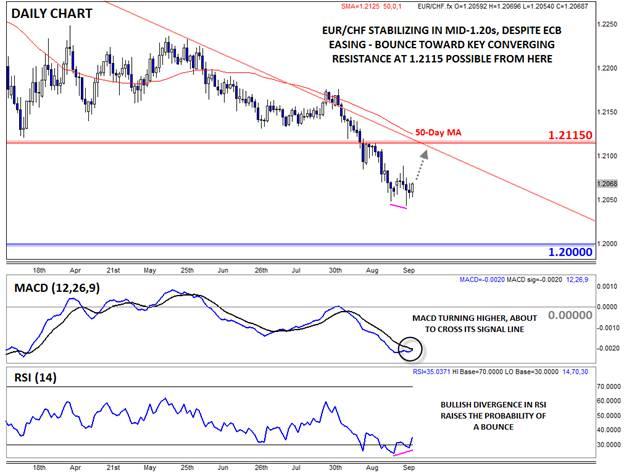![]()
After one of the quietest summers in recent memory, volatility may finally be returning to the FX market. The first week of September brought bold easing actions on the part of the European Central Bank, increasing concerns about Scottish Independence, and a disappointing Non-Farm Payroll report, among other high-impact releases. In the wake of these announcements, the US dollar index surged to within striking distance of a 4-year high, EURUSD dropped to a 1-year low, and GBPUSD is currently trading down nearly 500 pips(!) from last week’s open.
One pair that hasn’t seen volatility explode yet is EURCHF, though rates did tick down to new 21-month low at 1.2045 last week. Of course, the ECB’s dovish posture is the driving force behind the broad euro weakness, but the EURCHF is in a bit of a unique situation. Switzerland’s inflation rate has dropped to just 0.1% y/y, and further strength in the Swiss franc could only exacerbate the risk of deflation, the last thing the Swiss National Bank wants to see. As a result, we believe that the SNB will maintain the EURCHF floor at 1.20 for the foreseeable future, providing support for the pair. From a fundamental perspective, the SNB may eventually be forced to enact further rate cuts or nontraditional monetary policy measures; at the very minimum, the central bank won’t hesitate to use its record-high war chest of FX reserves to defend the floor if EURCHF nears 1.20.
Technical View: EURCHF
On a technical basis, there are signs that EURCHF may turn higher this week. After finding support around 1.2050 the last two weeks, rates are inching higher early in today’s trade. Looking to the secondary indicators, the MACD has started to turn higher and is about to cross its signal line, while the RSI indicator carved out a clear bullish divergence in oversold territory at the recent lows, suggesting that the selling momentum is waning.
If we do see a bounce emerge this week, strong resistance looms at around 1.2115, which represents the confluence of the 16-month bearish trend line, previous-support-turned-resistance at 1.2112, and the declining 50-day MA. Meanwhile, any additional downside may be limited to the 1.20 level, as both traders and the Swiss National Bank are likely to step in and provide support as rates approach that floor.
This research is for informational purposes and should not be construed as personal advice. Trading any financial market involves risk. Trading on leverage involves risk of losses greater than deposits.
Recommended Content
Editors’ Picks
EUR/USD regains traction, recovers above 1.0700

EUR/USD regained its traction and turned positive on the day above 1.0700 in the American session. The US Dollar struggles to preserve its strength after the data from the US showed that the economy grew at a softer pace than expected in Q1.
GBP/USD returns to 1.2500 area in volatile session

GBP/USD reversed its direction and recovered to 1.2500 after falling to the 1.2450 area earlier in the day. Although markets remain risk-averse, the US Dollar struggles to find demand following the disappointing GDP data.
Gold holds around $2,330 after dismal US data

Gold fell below $2,320 in the early American session as US yields shot higher after the data showed a significant increase in the US GDP price deflator in Q1. With safe-haven flows dominating the markets, however, XAU/USD reversed its direction and rose above $2,340.
XRP extends its decline, crypto experts comment on Ripple stablecoin and benefits for XRP Ledger

Ripple extends decline to $0.52 on Thursday, wipes out weekly gains. Crypto expert asks Ripple CTO how the stablecoin will benefit the XRP Ledger and native token XRP.
After the US close, it’s the Tokyo CPI

After the US close, it’s the Tokyo CPI, a reliable indicator of the national number and then the BoJ policy announcement. Tokyo CPI ex food and energy in Japan was a rise to 2.90% in March from 2.50%.
